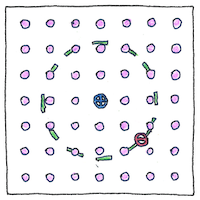Quasiparticles
Quasiparticles are not much different from particles except they don’t exist outside of a solid; they are not bound to others in a solid like real particles; they can’t flit freely in space like real or virtual particles. Collective excitations are like quasiparticles, but can’t be described, like quasiparticles, as though they were real particles whose behavior is altered by solids. Collective excitations are aggregate behaviors of solids. Quasiparticles and excitations are imaginary except, because all energy is quantized, the sums of fractional contributions behave as though they were wholes. Magnon, 1930 Felix Bloch introduced the magnon, a quantized spin wave, to explain the reduction of magnetization in a ferromagnet as it heats up. Fractional atomic spins combine to produce boson-like quasiparticles of spin-1. Exciton, 1931 Yakov Frenkel introduced the exciton, a negative electron bound to a positive electron hole, to describe movement through an insulator without the transfer of charge. Magnetic monopole, 1931 Paul Dirac accepted the hypothetical magnetic monopole, like a bar magnet but with only one pole, and showed that it explained charge quantization. Phonon, 1932 Igor Tamm introduced the phonon, a collective vibration of atoms or molecules, which is responsible for the thermal capacity of solids. Polaron, bipolaron, 1933 Lev Landau described the fermionic polaron, an electron moving through a dialectric crystal whose negative charge is countered by a phonon, a cloud of atoms in the crystal that bend out of their resting positions toward the electron. Two bound electrons, a Cooper pair, form a bipolaron when they share a phonon cloud. Majorana fermion, 1935 Ettore Majorana hypothesized the existence of a fermion that is its own antiparticle. Majorana fermions have subsequently been observed as collective exitations of other quasiparticles. Roton & maxon, 1939 Lev Landau described excitations of superfluidic liquid helium-4. Waves dispersing through this superfluid have different forms according to their momentum. Excitations where the momenta are linear are phonons. Excitations with momenta near the minimum are rotons. Excitations with momenta near the maximum are maxons. Quantum vortex, 1947 Lars Onsager predicted the existence of quantum vortices, quantized flux circulations that carry orbital angular momentum in superfluids and magnetic flux in superconductors. Polariton, 1950 Kirill Tolpygo predicted the bosonic polariton, which is a photon bound to optical phonons in ionic crystals, a photon bound to an exciton, or a photon coupled with a surface plasmon, by which light becomes a superfluid. Plasmon, 1952 David Pines and David Bohm proposed the plasmon, a quantization of plasma oscillations or a quantization of electron oscillations in a metal. Cooper pair, 1956 Leon Cooper pointed out that two electrons pair up when distorting a nearby positive lattice into a phonon and move with the phonon in a superconductor as a boson, without resistance. Fermi liquid theory, 1956 Lev Landau modeled interacting fermions in metals to show how they behave as liquids. In a Fermi liquid, interacting fermions form quasiparticles with altered masses and magnetic moments but whose spin, charge, and momentum are the same. Like fermions in a Fermi gas, Landau quasiparticles only weakly interact. Skyrmion, 1962 Tony Skyrme proposed the skyrmion, a model for protons and neutrons that predicts their low-energy properties. Plasmaron, 1971 A plasmaron is a plasmon bound to a charge-carrying electron that affects the movement of an electron hole. Electron hole, 1976 An electron hole is a moving position where an electron could be, thus having a positive charge of +e. Because electrons are lost near the top of the valence band, they have a negative mass and holes have a net positive mass. Fracton, 1983 A fracton is a collective vibration of a fractal substrate, having a hierarchy of vibrations that affect smaller and smaller parts of the fractal. Fractional quantum Hall effect, 1983 Robert B. Laughlin, Horst Ludwig Störmer, and Daniel Tsui described how when a two-dimensional conductor is subject to low temperatures and high magnetic fields, electrons bind with magnetic field lines to form quasiparticles with fractional elementary charges. Phason, 1985 A phason is similar to a phonon but exists only in a quasicrystal. Phonons are quantized vibrations of atoms; phasons are quantized rearrangements of atoms in the quasicrystal. Trion, 2000 A negative trion is two electrons bound to a hole; a positive trion is two holes bound to an electron. All trions are fermionic. Spin-charge separation, 1950-1998 Being fermions and having the same negative charge, electrons normally repel each other, but Shin'ichirō Tomonaga and Joaquin Mazdak Luttinger showed that electrons in a one-dimensional conductor when they are forced to move past each other can break down and interact like bosons, where their spin propagates independently from their charge. This is called spin-charge separation. An electron can be considered to be a bound state of three quasiparticles. A holon, also known as a chargeon, carries the electron charge. A spinon carries the electron spin. An orbiton carries the electron orbital location. Jeroen van den Brink, Khomskii, and Sawatzky predicted it in 1997-1998. Leviton, 2013 A leviton is an excitation of a single electron in a metal. Dropleton, 2014 A dropleton or quantum droplet is a bunch of electron and holes in a semiconductor that behave like a drop of liquid.
Sums of fundamentals
If there’s little difference between an electron and the emergent behavior of holon, spinon, and orbiton, why couldn’t even the most fundamental fermions be found to result from the sums of behavioral qualities? We could take this argument down many paths. A creature’s identity is bound to its behaviors, but the contributions to each creature seem limitless. It’s possible to discuss this only by simplifying greatly.
Emergence
(gestalt)




All things seem to result from sums of smaller things. An apple, for example, is the sum of materials contributed by the apple tree. But once it exists, it has its own qualities and its own development. Similarly, every “particle” is a part of something larger.
See also in The book of science:
Readings in wikipedia:
Other readings: